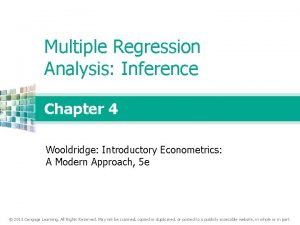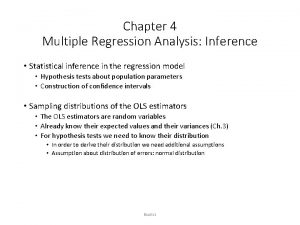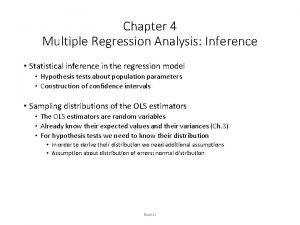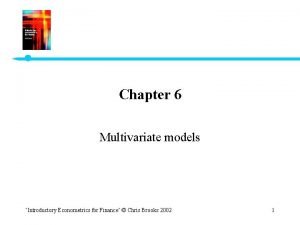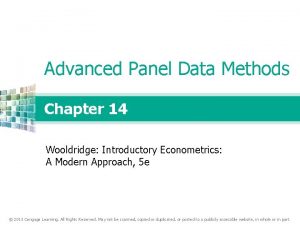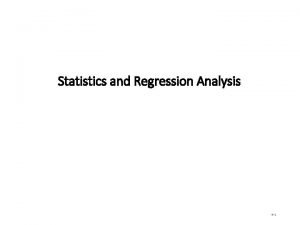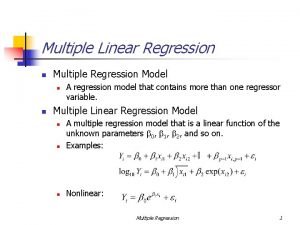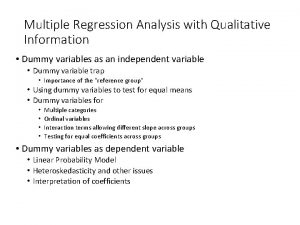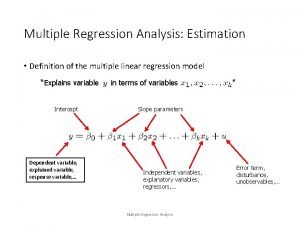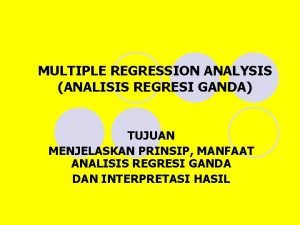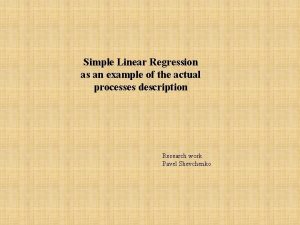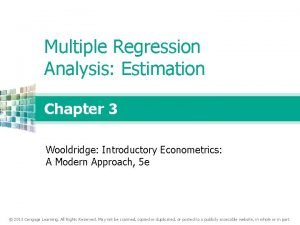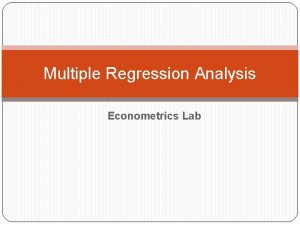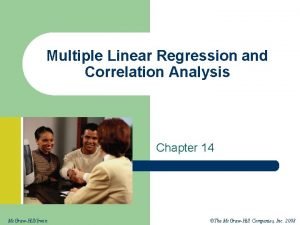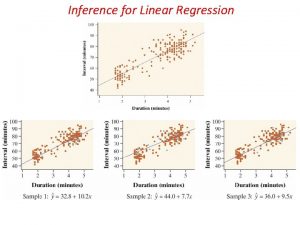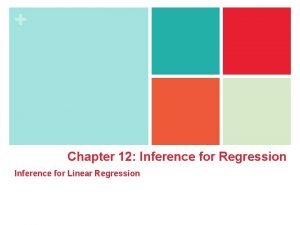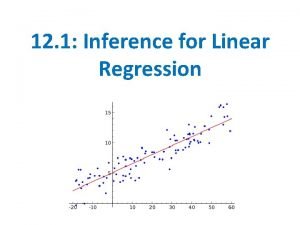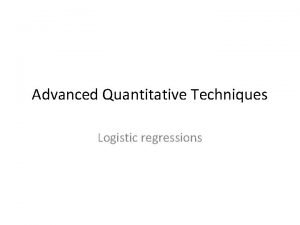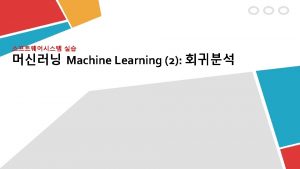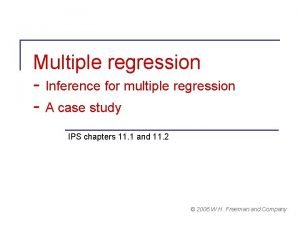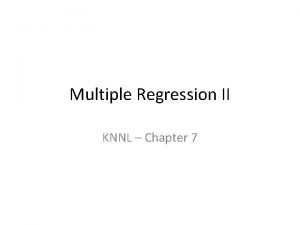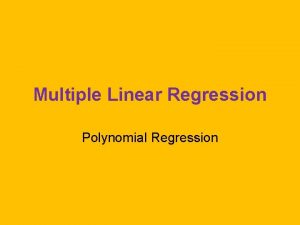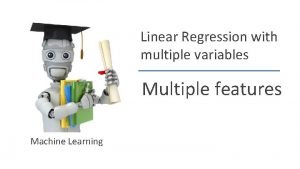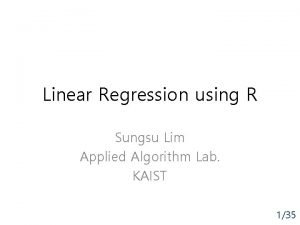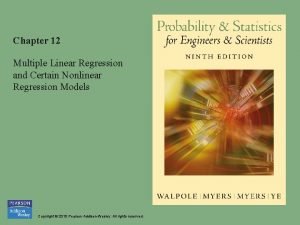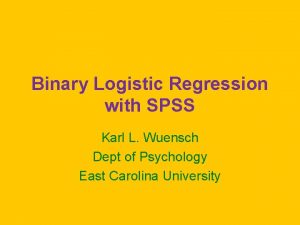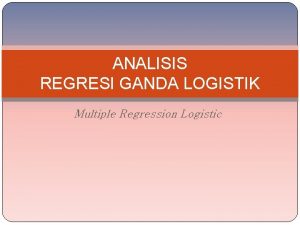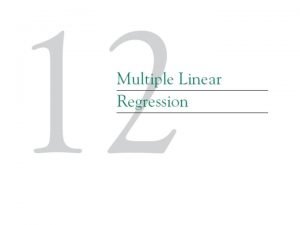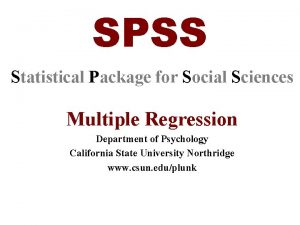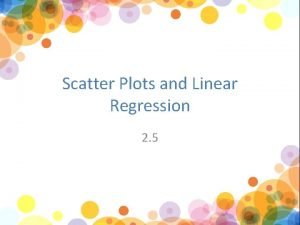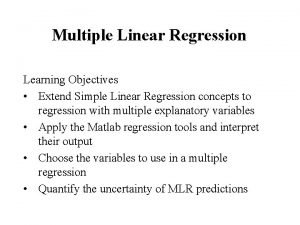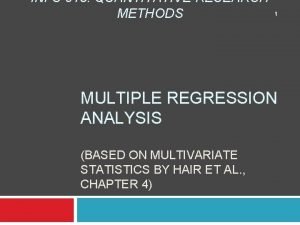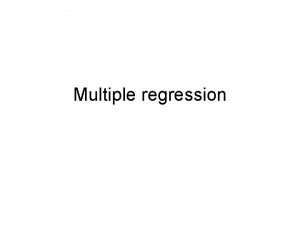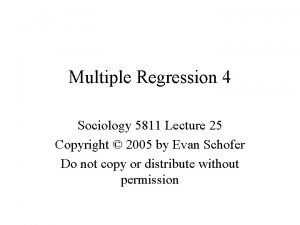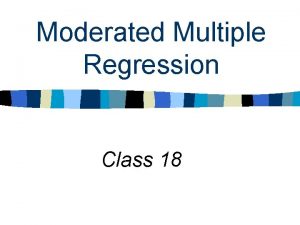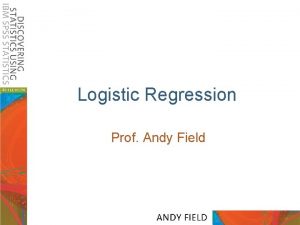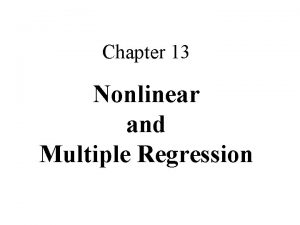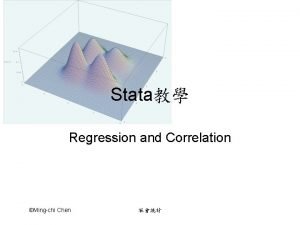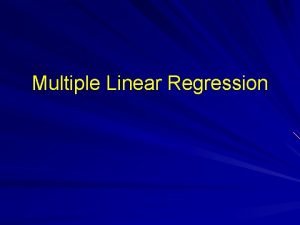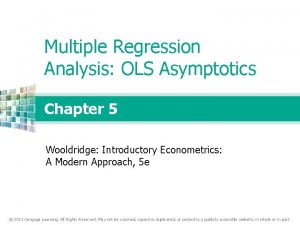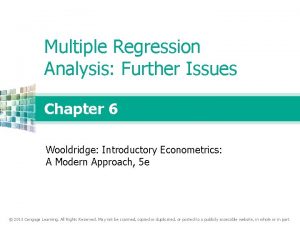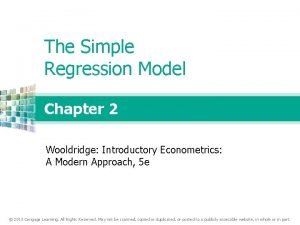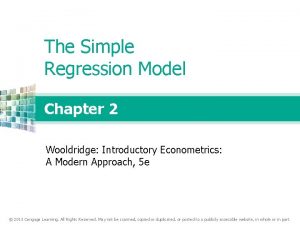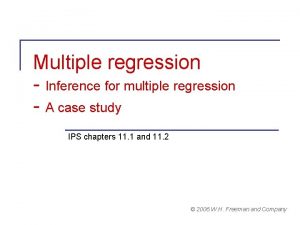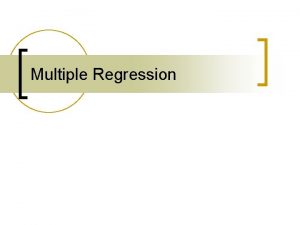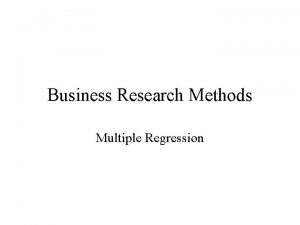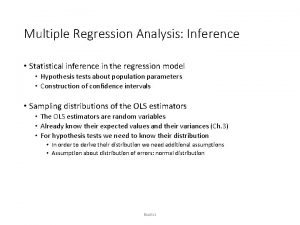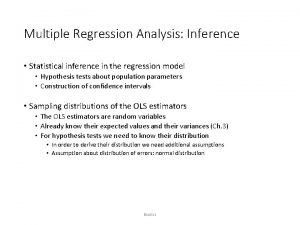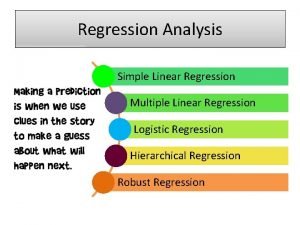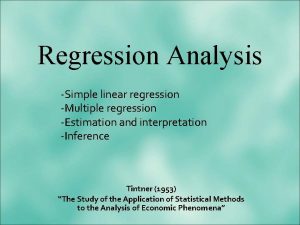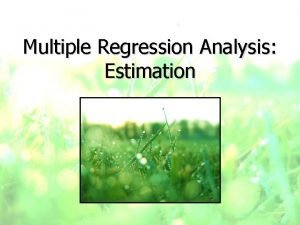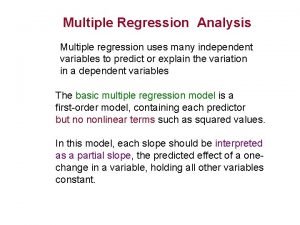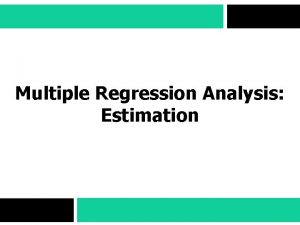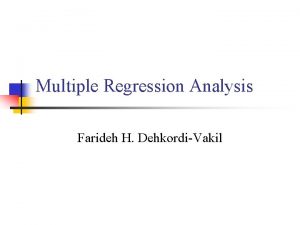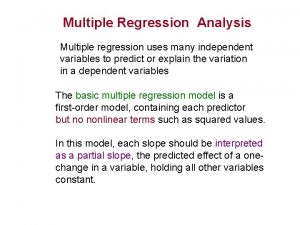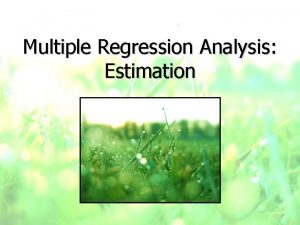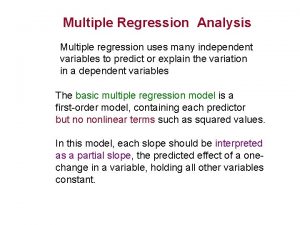Multiple Regression Analysis Inference Chapter 4 Wooldridge Introductory







































- Slides: 39

Multiple Regression Analysis: Inference Chapter 4 Wooldridge: Introductory Econometrics: A Modern Approach, 5 e © 2013 Cengage Learning. All Rights Reserved. May not be scanned, copied or duplicated, or posted to a publicly accessible website, in whole or in part.

Multiple Regression Analysis: Inference Statistical inference in the regression model Hypothesis tests about population parameters Construction of confidence intervals Sampling distributions of the OLS estimators The OLS estimators are random variables We already know their expected values and their variances However, for hypothesis tests we need to know their distribution In order to derive their distribution we need additional assumptions Assumption about distribution of errors: normal distribution © 2013 Cengage Learning. All Rights Reserved. May not be scanned, copied or duplicated, or posted to a publicly accessible website, in whole or in part.

Multiple Regression Analysis: Inference Assumption MLR. 6 (Normality of error terms) independently of It is assumed that the unobserved factors are normally distributed around the population regression function. The form and the variance of the distribution does not depend on any of the explanatory variables. It follows that: © 2013 Cengage Learning. All Rights Reserved. May not be scanned, copied or duplicated, or posted to a publicly accessible website, in whole or in part.

Multiple Regression Analysis: Inference Discussion of the normality assumption The error term is the sum of "many" different unobserved factors Sums of independent factors are normally distributed (CLT) Problems: • How many different factors? Number large enough? • Possibly very heterogenuous distributions of individual factors • How independent are the different factors? The normality of the error term is an empirical question At least the error distribution should be "close" to normal In many cases, normality is questionable or impossible by definition © 2013 Cengage Learning. All Rights Reserved. May not be scanned, copied or duplicated, or posted to a publicly accessible website, in whole or in part.

Multiple Regression Analysis: Inference Discussion of the normality assumption (cont. ) Examples where normality cannot hold: • Wages (nonnegative; also: minimum wage) • Number of arrests (takes on a small number of integer values) • Unemployment (indicator variable, takes on only 1 or 0) In some cases, normality can be achieved through transformations of the dependent variable (e. g. use log(wage) instead of wage) Under normality, OLS is the best (even nonlinear) unbiased estimator Important: For the purposes of statistical inference, the assumption of normality can be replaced by a large sample size © 2013 Cengage Learning. All Rights Reserved. May not be scanned, copied or duplicated, or posted to a publicly accessible website, in whole or in part.

Multiple Regression Analysis: Inference Terminology "Gauss-Markov assumptions" "Classical linear model (CLM) assumptions" Theorem 4. 1 (Normal sampling distributions) Under assumptions MLR. 1 – MLR. 6: The estimators are normally distributed around the true parameters with the variance that was derived earlier The standardized estimators follow a standard normal distribution © 2013 Cengage Learning. All Rights Reserved. May not be scanned, copied or duplicated, or posted to a publicly accessible website, in whole or in part.

Multiple Regression Analysis: Inference Testing hypotheses about a single population parameter Theorem 4. 1 (t-distribution for standardized estimators) Under assumptions MLR. 1 – MLR. 6: If the standardization is done using the estimated standard deviation (= standard error), the normal distribution is replaced by a t-distribution Note: The t-distribution is close to the standard normal distribution if n-k-1 is large. Null hypothesis (for more general hypotheses, see below) The population parameter is equal to zero, i. e. after controlling for the other independent variables, there is no effect of xj on y © 2013 Cengage Learning. All Rights Reserved. May not be scanned, copied or duplicated, or posted to a publicly accessible website, in whole or in part.

Multiple Regression Analysis: Inference t-statistic (or t-ratio) The t-statistic will be used to test the above null hypothesis. The farther the estimated coefficient is away from zero, the less likely it is that the null hypothesis holds true. But what does "far" away from zero mean? This depends on the variability of the estimated coefficient, i. e. its standard deviation. The t-statistic measures how many estimated standard deviations the estimated coefficient is away from zero. Distribution of the t-statistic if the null hypothesis is true Goal: Define a rejection rule so that, if it is true, H 0 is rejected only with a small probability (= significance level, e. g. 5%) © 2013 Cengage Learning. All Rights Reserved. May not be scanned, copied or duplicated, or posted to a publicly accessible website, in whole or in part.

Multiple Regression Analysis: Inference Testing against one-sided alternatives (greater than zero) Test against . Reject the null hypothesis in favour of the alternative hypothesis if the estimated coefficient is „too large“ (i. e. larger than a critical value). Construct the critical value so that, if the null hypothesis is true, it is rejected in, for example, 5% of the cases. In the given example, this is the point of the tdistribution with 28 degrees of freedom that is exceeded in 5% of the cases. ! Reject if t-statistic greater than 1. 701 © 2013 Cengage Learning. All Rights Reserved. May not be scanned, copied or duplicated, or posted to a publicly accessible website, in whole or in part.

Multiple Regression Analysis: Inference Example: Wage equation Test whether, after controlling for education and tenure, higher work experience leads to higher hourly wages Standard errors Test against . One would either expect a positive effect of experience on hourly wage or no effect at all. © 2013 Cengage Learning. All Rights Reserved. May not be scanned, copied or duplicated, or posted to a publicly accessible website, in whole or in part.

Multiple Regression Analysis: Inference Example: Wage equation (cont. ) t-statistic Degrees of freedom; here the standard normal approximation applies Critical values for the 5% and the 1% significance level (these are conventional significance levels). The null hypothesis is rejected because the t-statistic exceeds the critical value. "The effect of experience on hourly wage is statistically greater than zero at the 5% (and even at the 1%) significance level. " © 2013 Cengage Learning. All Rights Reserved. May not be scanned, copied or duplicated, or posted to a publicly accessible website, in whole or in part.

Multiple Regression Analysis: Inference Testing against one-sided alternatives (less than zero) Test against . Reject the null hypothesis in favour of the alternative hypothesis if the estimated coefficient is „too small“ (i. e. smaller than a critical value). Construct the critical value so that, if the null hypothesis is true, it is rejected in, for example, 5% of the cases. In the given example, this is the point of the tdistribution with 18 degrees of freedom so that 5% of the cases are below the point. ! Reject if t-statistic less than -1. 734 © 2013 Cengage Learning. All Rights Reserved. May not be scanned, copied or duplicated, or posted to a publicly accessible website, in whole or in part.

Multiple Regression Analysis: Inference Example: Student performance and school size Test whether smaller school size leads to better student performance Percentage of students passing maths test Test Average annual teacher compensation against Staff per one thousand students School enrollment (= school size) . Do larger schools hamper student performance or is there no such effect? © 2013 Cengage Learning. All Rights Reserved. May not be scanned, copied or duplicated, or posted to a publicly accessible website, in whole or in part.

Multiple Regression Analysis: Inference Example: Student performance and school size (cont. ) t-statistic Degrees of freedom; here the standard normal approximation applies Critical values for the 5% and the 15% significance level. The null hypothesis is not rejected because the t-statistic is not smaller than the critical value. One cannot reject the hypothesis that there is no effect of school size on student performance (not even for a lax significance level of 15%). © 2013 Cengage Learning. All Rights Reserved. May not be scanned, copied or duplicated, or posted to a publicly accessible website, in whole or in part.

Multiple Regression Analysis: Inference Example: Student performance and school size (cont. ) Alternative specification of functional form: R-squared slightly higher Test against . © 2013 Cengage Learning. All Rights Reserved. May not be scanned, copied or duplicated, or posted to a publicly accessible website, in whole or in part.

Multiple Regression Analysis: Inference Example: Student performance and school size (cont. ) t-statistic Critical value for the 5% significance level ! reject null hypothesis The hypothesis that there is no effect of school size on student performance can be rejected in favor of the hypothesis that the effect is negative. How large is the effect? + 10% enrollment ! -0. 129 percentage points students pass test (small effect) © 2013 Cengage Learning. All Rights Reserved. May not be scanned, copied or duplicated, or posted to a publicly accessible website, in whole or in part.

Multiple Regression Analysis: Inference Testing against two-sided alternatives Test against . Reject the null hypothesis in favour of the alternative hypothesis if the absolute value of the estimated coefficient is too large. Construct the critical value so that, if the null hypothesis is true, it is rejected in, for example, 5% of the cases. In the given example, these are the points of the t-distribution so that 5% of the cases lie in the two tails. ! Reject if absolute value of t-statistic is less than -2. 06 or greater than 2. 06 © 2013 Cengage Learning. All Rights Reserved. May not be scanned, copied or duplicated, or posted to a publicly accessible website, in whole or in part.

Multiple Regression Analysis: Inference Example: Determinants of college GPA Lectures missed per week For critical values, use standard normal distribution The effects of hs. GPA and skipped are significantly different from zero at the 1% significance level. The effect of ACT is not significantly different from zero, not even at the 10% significance level. © 2013 Cengage Learning. All Rights Reserved. May not be scanned, copied or duplicated, or posted to a publicly accessible website, in whole or in part.

Multiple Regression Analysis: Inference "Statistically significant“ variables in a regression If a regression coefficient is different from zero in a two-sided test, the corresponding variable is said to be "statistically significant“ If the number of degrees of freedom is large enough so that the normal approximation applies, the following rules of thumb apply: "statistically significant at 10 % level“ "statistically significant at 5 % level“ "statistically significant at 1 % level“ © 2013 Cengage Learning. All Rights Reserved. May not be scanned, copied or duplicated, or posted to a publicly accessible website, in whole or in part.

Multiple Regression Analysis: Inference Guidelines for discussing economic and statistical significance If a variable is statistically significant, discuss the magnitude of the coefficient to get an idea of its economic or practical importance The fact that a coefficient is statistically significant does not necessarily mean it is economically or practically significant! If a variable is statistically and economically important but has the "wrong“ sign, the regression model might be misspecified If a variable is statistically insignificant at the usual levels (10%, 5%, 1%), one may think of dropping it from the regression If the sample size is small, effects might be imprecisely estimated so that the case for dropping insignificant variables is less strong © 2013 Cengage Learning. All Rights Reserved. May not be scanned, copied or duplicated, or posted to a publicly accessible website, in whole or in part.

Multiple Regression Analysis: Inference Testing more general hypotheses about a regression coefficient Null hypothesis Hypothesized value of the coefficient t-statistic The test works exactly as before, except that the hypothesized value is substracted from the estimate when forming the statistic © 2013 Cengage Learning. All Rights Reserved. May not be scanned, copied or duplicated, or posted to a publicly accessible website, in whole or in part.

Multiple Regression Analysis: Inference Example: Campus crime and enrollment An interesting hypothesis is whether crime increases by one percent if enrollment is increased by one percent Estimate is different from one but is this difference statistically significant? The hypothesis is rejected at the 5% level © 2013 Cengage Learning. All Rights Reserved. May not be scanned, copied or duplicated, or posted to a publicly accessible website, in whole or in part.

Multiple Regression Analysis: Inference Computing p-values for t-tests If the significance level is made smaller and smaller, there will be a point where the null hypothesis cannot be rejected anymore The reason is that, by lowering the significance level, one wants to avoid more and more to make the error of rejecting a correct H 0 The smallest significance level at which the null hypothesis is still rejected, is called the p-value of the hypothesis test A small p-value is evidence against the null hypothesis because one would reject the null hypothesis even at small significance levels A large p-value is evidence in favor of the null hypothesis P-values are more informative than tests at fixed significance levels © 2013 Cengage Learning. All Rights Reserved. May not be scanned, copied or duplicated, or posted to a publicly accessible website, in whole or in part.

Multiple Regression Analysis: Inference How the p-value is computed (here: two-sided test) The p-value is the significance level at which one is indifferent between rejecting and not rejecting the null hypothesis. These would be the critical values for a 5% significance level In the two-sided case, the p-value is thus the probability that the t-distributed variable takes on a larger absolute value than the realized value of the test statistic, e. g. : From this, it is clear that a null hypothesis is rejected if and only if the corresponding pvalue is smaller than the significance level. value of test statistic For example, for a significance level of 5% the t-statistic would not lie in the rejection region. © 2013 Cengage Learning. All Rights Reserved. May not be scanned, copied or duplicated, or posted to a publicly accessible website, in whole or in part.

Multiple Regression Analysis: Inference Critical value of two-sided test Confidence intervals Simple manipulation of the result in Theorem 4. 2 implies that Lower bound of the Confidence interval Upper bound of the Confidence interval Confidence level Interpretation of the confidence interval The bounds of the interval are random In repeated samples, the interval that is constructed in the above way will cover the population regression coefficient in 95% of the cases © 2013 Cengage Learning. All Rights Reserved. May not be scanned, copied or duplicated, or posted to a publicly accessible website, in whole or in part.

Multiple Regression Analysis: Inference Confidence intervals for typical confidence levels Use rules of thumb Relationship between confidence intervals and hypotheses tests reject in favor of © 2013 Cengage Learning. All Rights Reserved. May not be scanned, copied or duplicated, or posted to a publicly accessible website, in whole or in part.

Multiple Regression Analysis: Inference Example: Model of firms‘ R&D expenditures Spending on R&D Annual sales The effect of sales on R&D is relatively precisely estimated as the interval is narrow. Moreover, the effect is significantly different from zero because zero is outside the interval. Profits as percentage of sales This effect is imprecisely estimated as the interval is very wide. It is not even statistically significant because zero lies in the interval. © 2013 Cengage Learning. All Rights Reserved. May not be scanned, copied or duplicated, or posted to a publicly accessible website, in whole or in part.

Multiple Regression Analysis: Inference Testing hypotheses about a linear combination of parameters Example: Return to education at 2 year vs. at 4 year colleges Years of education at 2 year colleges Test Years of education at 4 year colleges against . A possible test statistic would be: The difference between the estimates is normalized by the estimated standard deviation of the difference. The null hypothesis would have to be rejected if the statistic is "too negative" to believe that the true difference between the parameters is equal to zero. © 2013 Cengage Learning. All Rights Reserved. May not be scanned, copied or duplicated, or posted to a publicly accessible website, in whole or in part.

Multiple Regression Analysis: Inference Impossible to compute with standard regression output because Usually not available in regression output Alternative method Define and test Insert into original regression against . a new regressor (= total years of college) © 2013 Cengage Learning. All Rights Reserved. May not be scanned, copied or duplicated, or posted to a publicly accessible website, in whole or in part.

Multiple Regression Analysis: Inference Estimation results Total years of college Hypothesis is rejected at 10% level but not at 5% level This method works always for single linear hypotheses © 2013 Cengage Learning. All Rights Reserved. May not be scanned, copied or duplicated, or posted to a publicly accessible website, in whole or in part.

Multiple Regression Analysis: Inference Testing multiple linear restrictions: The F-test Testing exclusion restrictions Salary of major league base ball player Batting average Years in the league Average number of games per year Home runs per year Runs batted in per year against Test whether performance measures have no effect/can be exluded from regression. © 2013 Cengage Learning. All Rights Reserved. May not be scanned, copied or duplicated, or posted to a publicly accessible website, in whole or in part.

Multiple Regression Analysis: Inference Estimation of the unrestricted model None of these variabels is statistically significant when tested individually Idea: How would the model fit be if these variables were dropped from the regression? © 2013 Cengage Learning. All Rights Reserved. May not be scanned, copied or duplicated, or posted to a publicly accessible website, in whole or in part.

Multiple Regression Analysis: Inference Estimation of the restricted model The sum of squared residuals necessarily increases, but is the increase statistically significant? Test statistic Number of restrictions The relative increase of the sum of squared residuals when going from H 1 to H 0 follows a F-distribution (if the null hypothesis H 0 is correct) © 2013 Cengage Learning. All Rights Reserved. May not be scanned, copied or duplicated, or posted to a publicly accessible website, in whole or in part.

Multiple Regression Analysis: Inference Rejection rule (Figure 4. 7) A F-distributed variable only takes on positive values. This corresponds to the fact that the sum of squared residuals can only increase if one moves from H 1 to H 0. Choose the critical value so that the null hypothesis is rejected in, for example, 5% of the cases, although it is true. © 2013 Cengage Learning. All Rights Reserved. May not be scanned, copied or duplicated, or posted to a publicly accessible website, in whole or in part.

Multiple Regression Analysis: Inference Test decision in example Number of restrictions to be tested Degrees of freedom in the unrestricted model The null hypothesis is overwhelmingly rejected (even at very small significance levels). Discussion The three variables are "jointly significant" They were not significant when tested individually The likely reason is multicollinearity between them © 2013 Cengage Learning. All Rights Reserved. May not be scanned, copied or duplicated, or posted to a publicly accessible website, in whole or in part.

Multiple Regression Analysis: Inference Test of overall significance of a regression The null hypothesis states that the explanatory variables are not useful at all in explaining the dependent variable Restricted model (regression on constant) The test of overall significance is reported in most regression packages; the null hypothesis is usually overwhelmingly rejected © 2013 Cengage Learning. All Rights Reserved. May not be scanned, copied or duplicated, or posted to a publicly accessible website, in whole or in part.

Multiple Regression Analysis: Inference Testing general linear restrictions with the F-test Example: Test whether house price assessments are rational Actual house price The assessed housing value (before the house was sold) Square footage Size of lot (in feet) Number of bedrooms If house price assessments are rational, a 1% change in the assessment should be associated with a 1% change in price. In addition, other known factors should not influence the price once the assessed value has been controlled for. © 2013 Cengage Learning. All Rights Reserved. May not be scanned, copied or duplicated, or posted to a publicly accessible website, in whole or in part.

Multiple Regression Analysis: Inference Unrestricted regression Restricted regression The restricted model is actually a regression of [y-x 1] on a constant Test statistic cannot be rejected © 2013 Cengage Learning. All Rights Reserved. May not be scanned, copied or duplicated, or posted to a publicly accessible website, in whole or in part.

Multiple Regression Analysis: Inference Regression output for the unrestricted regression When tested individually, there is also no evidence against the rationality of house price assessments The F-test works for general multiple linear hypotheses For all tests and confidence intervals, validity of assumptions MLR. 1 – MLR. 6 has been assumed. Tests may be invalid otherwise. © 2013 Cengage Learning. All Rights Reserved. May not be scanned, copied or duplicated, or posted to a publicly accessible website, in whole or in part.
 Multiple regression analysis inference
Multiple regression analysis inference Multiple regression analysis inference
Multiple regression analysis inference Multiple regression analysis inference
Multiple regression analysis inference Wooldridge chapter 6 solutions
Wooldridge chapter 6 solutions Wooldridge econometrics slides
Wooldridge econometrics slides Simple linear regression and multiple linear regression
Simple linear regression and multiple linear regression Linear regression vs multiple regression
Linear regression vs multiple regression Multiple regression analysis with qualitative information
Multiple regression analysis with qualitative information Definition of multiple regression
Definition of multiple regression Multiple regression analysis adalah
Multiple regression analysis adalah Multiple linear regression analysis formula
Multiple linear regression analysis formula Direction of omitted variable bias
Direction of omitted variable bias Dataset for regression analysis
Dataset for regression analysis Multiple linear regression minitab
Multiple linear regression minitab Regression inference conditions
Regression inference conditions Conditions for regression inference
Conditions for regression inference Conditions for inference regression
Conditions for inference regression Survival analysis vs logistic regression
Survival analysis vs logistic regression Logistic regression vs linear regression
Logistic regression vs linear regression Multiple linear regression model
Multiple linear regression model Confidence interval multiple regression
Confidence interval multiple regression Extra sum of squares multiple regression
Extra sum of squares multiple regression Polynomial regression spss
Polynomial regression spss Linear regression with multiple variables machine learning
Linear regression with multiple variables machine learning Sum of squares
Sum of squares Multiple nonlinear regression spss
Multiple nonlinear regression spss Binary logistic regression spss
Binary logistic regression spss Perbedaan analisis regresi berganda dan logistik
Perbedaan analisis regresi berganda dan logistik Multiple linear regression variance
Multiple linear regression variance Hierarchical multiple regression spss
Hierarchical multiple regression spss Multiple regression scatter plot
Multiple regression scatter plot Kr
Kr Multiple regression research design
Multiple regression research design Linear regression spss
Linear regression spss Hypothesis for multiple regression
Hypothesis for multiple regression Moderated multiple regression
Moderated multiple regression Andy field logistic regression
Andy field logistic regression Nonlinear multiple regression
Nonlinear multiple regression Multiple nonlinear regression excel
Multiple nonlinear regression excel Draw a correlation
Draw a correlation
